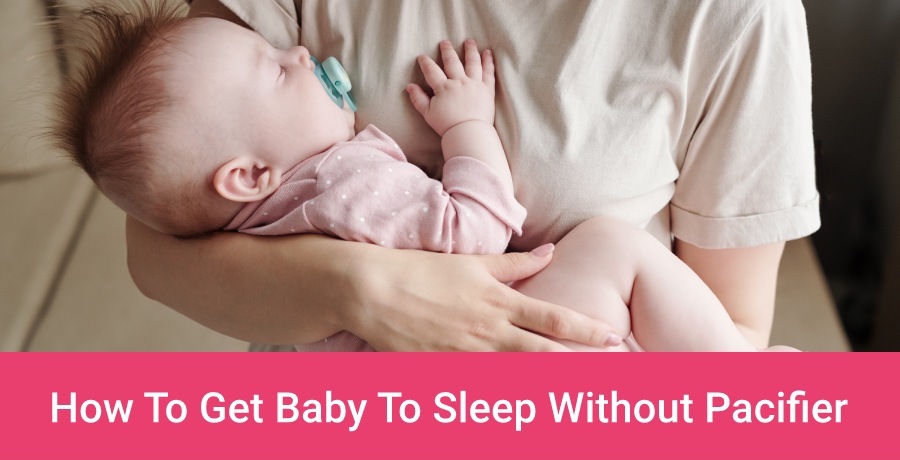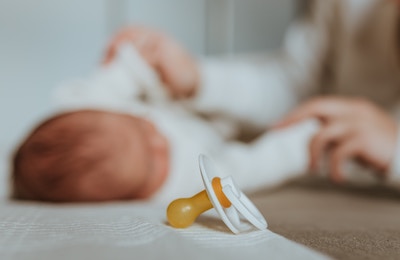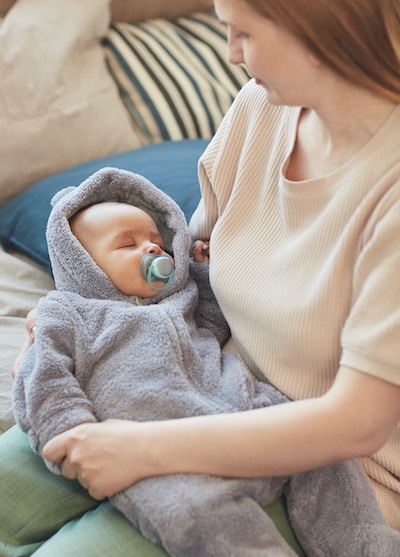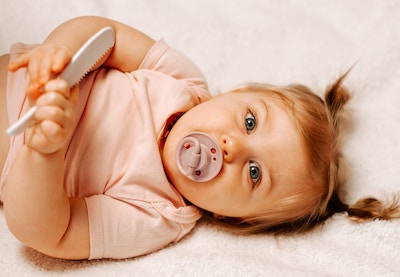
Medically reviewed by Raye Mariano – RN, BSN, BA
If you’re a mom of little ones then you know how fun and rewarding, yet also how difficult these early stages can be! From newborn babies to toddlerhood to preschooler your child will go through many transitions and face obstacles that you might not have expected. One challenge that many families experience is when it comes time to wean your little one from their beloved pacifier.
While some babies refuse to take a pacifier at all in the first place, others develop a serious attachment to their paci, binky, nunu, or whatever you decide to call their favorite soother. Then, when it’s time to take the pacifier away, some children couldn’t care less while others really struggle with not having the comfort of their pacifier.
Many babies might incessantly cry or older children might throw tantrums in its absence. Babies or toddlers alike could have trouble falling asleep, as well as staying asleep through the night.
When it comes down to it, all children will give it up eventually it’s just a matter of when and how. Maybe you are getting worried or concerned thinking about the inevitable time when you’ll have to take it away. Maybe you have even tried to take it away before but without success.
Having recently gone through this transition with my two daughters, I can definitely tell you it is a challenging time but by no means is it impossible! Here’s some valuable information that I’ve gathered throughout this pacifier weaning process so you can determine the best way to go about it when the time is right.
| PRO TIP: Are you struggling with other baby sleep issues? If your little one is only cat napping, check out our best solutions to try if your baby doesn’t nap for more than 30 minutes. Or maybe you’re looking for advise what to do when toddler fights nap time? Here are our tips for surviving 2-year-old nap strike! |
This article is not a substitute for medical advice or consultation
Are Pacifiers Necessary? – Safety Recommendations From AAP
For healthy babies born full-term, pacifiers aren’t necessary but are recommended by the American Academy of Pediatrics.
According to the AAP, pacifier usage might actually help reduce SIDS (Sudden Infant Death Syndrome) in babies when used at naptime and bedtime. SIDS is the sudden death of a baby when sleeping within the first year of life. While they don’t exactly know why, studies have shown that the pacifier provides a protective effect against SIDS1.
The AAP also emphasizes that using the pacifier for sleep should always be done safely. Safe pacifier use means not attaching it with a clip or string when your baby is sleeping. You also shouldn’t have objects attached to it like a stuffed animal or blanket when sleeping. And, as always, safe sleep means the baby sleeps on their back and on a flat surface in the crib with no blankets, bumpers, stuffed animals, or any other extra objects in the crib2.
So, while pacifiers aren’t technically necessary for most babies, they are clearly recommended by the experts and that’s why so many moms and dads choose to use them for their babies!
Pros & Cons Of Sleeping With Pacifier
Pros – The Good Things About Using The Pacifier
- Soothes and calms baby when fussy/ helps baby settle
- Protects against Sudden Infant Death Syndrome3
- Assists getting an overtired or overstimulated baby to fall asleep
- Satisfies suck reflex which gives breastfeeding mom a break from comfort sucking4
- Pain relief intervention during procedures like circumcision or immunizations5
- May help reflux – Pacifier use stimulates more saliva production which is a natural antacid6
Cons – The Bad Side To Using The Pacifier
- Nipple confusion – You should hold off introducing the pacifier to a newborn until breastfeeding is firmly established to avoid problems with latching
- Malocclusion/ misalignment of teeth7 – Prolonged pacifier use can cause an open bite where the top and bottom rows of teeth do not line up properly (after age 3)
- Other dental problems like tooth decay8
- Infections – Overuse can cause otitis media (ear infections) and viral infections9
- Potential for speech problems in older toddlers
- Fragmented sleep – Baby waking up crying when they discover their pacifier has fallen out
What Is The Right Time For Pacifier Weaning?
The AAP and the AAFP (American Academy of Family Physicians) both recommend pacifier use up until 6 months old and after that to begin the weaning process10. For the first year of life, pacifier use helps prevent SIDS, however, after 6 months old is when you might start to see some issues crop up.
Other experts say your should wean off pacifier between 2 and 4 years11.

The earlier you remove the pacifier, then the less you’ll probably have to deal with some complications like middle ear infections or viral infections. However, the reality of the situation is that some toddlers really do need the pacifier longer than 2 years old. For those babies, it’s recommended not to use the pacifier past 3 years old to avoid causing any long term dental effects!
Eliminating the pacifier completely around 6 months will also help your baby establish healthy sleep patterns. Without the crutch of the pacifier, they will be able to fall asleep independently and will also be able to get more solid, uninterrupted sleep since they won’t keep waking to look for a pacifier that fell out of their mouth.
So according to the research, 6 months is a good age to call it quits. If you must continue it’s use then definitely ditch the binky before the third birthday. Ultimately, it is your own decision so do what feels right for you, your child, and your family.
When Should Baby Stop Sleeping With Pacifier
Signs your little one is ready to wean off the pacifier at sleep time:
- They stay asleep throughout the night without continued night wakings
- You notice baby chewing on it instead of sucking
- You observe holes or indentations from aggressive chewing
More reasons that it’s really time to start the weaning process:
- Chronic ear infections
- You or your child’s dentist notice what’s called “pacifier mouth” or “open bite”
- Baby wakes up all night throughout the night looking for pacifier when it falls out
- Your child is older than 24 months old
How Do I Get My Child To Sleep Without A Pacifier? – 9 Best Methods
Of course there are different ways to go about pacifier removal based on your baby’s age as well as maturity level. Here are some helpful tips for if you want to wean your younger babies off of the pacifier to ultimately promote independent sleep!
Pacifier Weaning Methods – Younger Babies
Cold Turkey Method
This is by far the fastest way to get rid of the pacifier. For this method, you would simply take the pacifier away altogether12. Many parents literally throw them all out so there’s no going back.
When putting them down for sleep without the pacifier, you should offer as much comfort as needed until your baby falls asleep. Don’t forget to stick to your regular bedtime routine including sleep cues.
For wakings during nighttime sleep, you won’t be able to just pop their pacifier back in so you’ll need to use other tools to help soothe baby back to sleep until they are able to self-soothe on their own. Be present at their crib, using your voice and gentle touch so they know you are there.

Pull Out Method (Pantley Pull Off)
This is a more gradual approach to weaning where you place the baby in their crib with the pacifier as you normally would at naptime or bedtime13.
As their sucking gradually decreases you will take the pacifier out of the baby’s mouth before the baby is fully asleep. At first they will likely get upset or stir around looking for it. Then repeat this each time until your baby no longer needs the pacifier to sleep.
Sleep Associations
If your normal routine is popping a pacifier in your baby’s mouth and plopping them in their crib to sleep then when you remove the pacifier they are left with nothing! Make sure when putting your baby to sleep you incorporate many sleep cues that they will associate with bedtime, like dim lighting, soothing lullaby music, white noise machine, and giving a bath and lotion massage right before it’s time for sleep.
Pacifier Weaning Methods – Toddlers/Kids
If you have a toddler then the weaning process will have to be a bit different. Since many children this age understand that their pacifier has been taken away, most parents choose to include them in the decision process. Here are some tips for getting rid of the pacifier for your older babies or toddler – ages two and up.
Cold Turkey Method
Just throw the pacifiers away and don’t look back. However, be sure to first have a solid bedtime routine in place. This is extremely important since they won’t have their pacifier they will rely more heavily on their other comfortable sleeping cues.
Many parents will also explain to your toddler that the day is coming when it will be gone so they aren’t completely blindsided. Also, don’t do it when your child isn’t feeling well at the moment like if they are teething, coming down with a sickness or just getting over being sick. This will just make it harder on everyone.
Gradual Bye-Bye
If you can’t do a cold turkey approach or simply don’t want to, there are other ways to go about it. For a toddler you can start to limit use in the day so that it’s not always there as a crutch and not constantly attached to their hip. You can start by only allowing use during nap time and sleep at first before taking it away altogether. Then eliminate from naps, before taking it away completely. This can help a toddler mentally prepare for its departure.
New Lovey
Have your toddler exchange their pacifier for a new lovey like a blanket or stuffed animal of their choice. That way they are having some more control over the new method of comfort at bedtime. They give you the pacifier as payment for their new prize. Some companies even make stuffed animals that are specifically marketed towards a toddler weaning from the pacifier– so that’s something to look into!
Pacifier Fairy
This is actually the approach I took with my toddlers. The idea is that the fairy is coming to take the binky to a new baby. Parents sometimes choose to leave a small surprise. The surprise can be a new sleep prop like a blanket or stuffed animal. This method works when the child is old enough to understand that they are sharing and helping out another baby and they are now a “big girl” or “big boy”.
Praise And Rewards
This one probably goes without saying but child will need extra encouragement and words of affirmation to get through this difficult time. If you are removing it gradually you can also implement a type of reward system like a sticker chart, feel free to get creative with it!

Extra Things To Try
- Give extra cuddles and reassurance during this tough time.
- Tire them out during the day so they are sure to be sleepy at bed time.
- Children’s books about getting rid of the pacifier may be helpful for small children to understand why it’s time to ditch the binky.
How Long Does It Take For Baby To Sleep Without Pacifier?
It depends. Every baby is different – each individual has their own personality and temperament and that definitely plays a role in how easy or hard the whole process will go. Just like all babies are different, so are all parents, each with their own parenting styles and that will also affect how quickly the transition occurs.
If you go cold turkey then you are looking at around 2-3 nights of bedtime battles. It could even be 4 nights before most children can successfully go to sleep and stay asleep without the pacifier. If you opt for a more gradual method then it could be 2-3 days or even as long as 10-14 days.
Don’t be surprised if you give in to your child when they are inconsolable and you can’t take i any more and you just really need to get some sleep. It wouldn’t be the first time that’s happened. However, if you do let them have the pacifier for sleep then know that you will have to start the weaning and sleep train all over again over from scratch. So try your hardest to be strong and not give in. Hang in there mama, here is a good night’s sleep in your near future!
How To Make Nighttime Without Pacifier Easier
The key to being able to promote baby’s own self-soothing is to make sure you first have a solid sleep routine in place. This should be a 15-20 minute process where parents go through the same motions at the same time every night just prior to putting baby down in the crib.
This helps the baby learn sleep association and that it is indeed time to go to sleep. Keep reading for some strategies for your child’s bedtime routine that are sure to make your baby calm and comfortable enough at bedtime to promote pacifier free sleep.

Pacifier Waning Process – FAQ
Here are few more things you need to know about pacifier weaning and how to get your baby to sleep without paci (and still sleep through the night!).
How Can I Get My Baby To Self Soothe Without A Pacifier?
- Dim lighting or dark room
- Soft, soothing sounds, lullaby music or white noise
- Eliminate potential distractions from environment like noise from siblings
- Swaddle (for newborns)
- Warm bath at the start of routine, followed by pajamas
- Quiet bedtime story
Is It Safe For Baby To Sleep Without Pacifier?
Yes, it is safe for a baby to sleep without the pacifier. There’s no rule saying you HAVE TO give your baby a pacifier. Additionally, not all babies will take a pacifier, even if it’s offered.
Some babies refuse to even hold the pacifier in their mouth like my youngest baby who would spit it practically across the room. Also, keep in mind that some babies gag on pacifier without any specific health issues (at first it may be because they are not used to it, or because they just don’t want it).
How Do I Stop My Baby From Being Dependent On A Pacifier?
The only way to stop your baby from being dependent on a pacifier is to take it away. I know that is much easier said than done. Discuss the methods with your family and choose one that you think would work best and then be sure to keep the other tips in mind. Remember, if it doesn’t work you can always just try a new strategy. If you can’t stick with it for your own sanity, you can always abort the mission and try again.
Is Pacifier Or Thumb Better?
Believe it or not, the pacifier is actually much better option than sucking on a thumb. Thumb sucking causes worse problems for teeth alignment and it is also a less sanitary option being how germy hands can be. Most importantly, you can’t get rid of a thumb so there’s really no option of taking it away when it’s time. This can lead to more long-term problems than when using a pacifier.
Article By Raye Mariano, RN, BSN, BA
Raye Mariano is a Registered Nurse who worked for years as a labor and delivery nurse and mother/baby nurse. Now, as a stay-at-home mom to 3 kids, ages 4 and under, she remains passionate about all things pregnancy, postpartum, and parenting.
The purpose of this article is informative. It’s not a substitute for professional medical advice or medical care. Remember: safety first! Consult your doctor/pediatrician in case of any doubts. The author of this article does not accept any responsibility for any liability, loss or risk, personal or otherwise, incurred as a consequence, directly or indirectly, from any information or advice contained here.
References:
https://publications.aap.org
https://www.wonderbaby.org/
https://www.preciouslittlesleep.com
https://www.slumberpod.com/
https://www.healthline.com/
https://snoozeshade.com/

